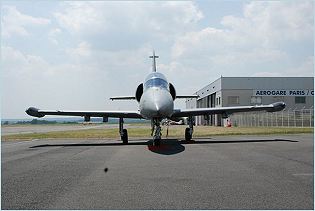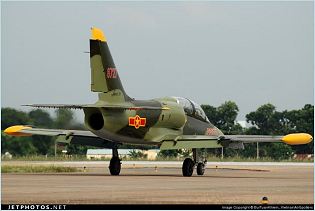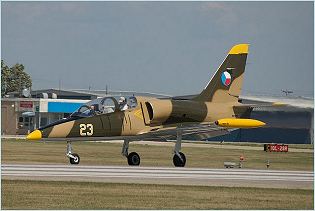L-39 Albatros
| a | ||||||||||||||||||||||
|
L-39 Albatros jet trainer combat aircraft
|
||||||||||||||||||||||
 |
||||||||||||||||||||||
|
|
||||||||||||||||||||||
|
The Aero L-39 Albatros is a high-performance jet trainer aircraft developed in Czechoslovakia to meet requirements for a trainer aircraft during the 1960s to replace the L-29 Delfín. Designed before the Soviet armed intervention in Czechoslovakia in 1968, the Aero L-39 Albatros is now wellon the road to emulating its predecessor, the L-29 Delfin, as the standard jet trainer for Warsaw Pact (except Poland) and other airforces. Aero began with three prototypes, the middle one of which flew for the first time on 4 November 1968; the other two were subjected to structural and fatigue tests. Pilot for the first flight was Rudolf Duchon, who had also been responsible for the early test programmeof the L-29 nine years before. The powerplant selected for the L-39 is the Soviet-designed Ivchenko AI-25 turbofan, and most of the early delays in the aircraft's development are thought to be the result of problems encountered in relating this to the L-39's airframe, so ren- dering it acceptable for licence production in Czechoslovakia. One of the chief problems seems to have been the supply of air to the engine: by late 1970, at which time five flying prototypes had been completed, modified intakes of greater length and increased area were noticed on these development aircraft. During the following year, a pre-production batch of 10 L-39s was built to the modified configuration, and series production began in late 1972. By 1979, more than 1,000 had been ordered, of which more than half had been completed. These are of three main versions. The basic L-39C, for elementary and advanced jet training, has been supplied in quantity to the Czech and Soviet air forces plus those of other Warsaw Pact nations as a successor to the L-29; it began to enter service in 1974. When equipped for weapons training, the two-seater is known as the L-39Z. A single-seat armed variant, for use in the light close-support and ground-attack roles, is designated L-390: Iraq is known to be among the operators of this last version. Dipl.-Ing. Jan Vlcek, who led the Aero design team responsible for the L-39, has produced a physically attractive little aeroplane with a significant improvement in performance over its predecessor (Mach 0.83 top speed, compared with the L-29's Mach 0.75). Tandem seating (on zero-height ejection seats in the L39C) is retained, but naturally with the rear (instructor's) seat elevated to improve his view forward. Simultaneously, this enables the lower-placed front cockpit to slope downward towards a finely- pointed nose that reduces drag and contributes to enhanced performance.
|
||||||||||||||||||||||
| Variants | ||||||||||||||||||||||
|
- L-39C: Standard basic trainer for Czech Republic and export. Originally designated L-39, but renamed L-39C when later variants appeared. Two pylons under wing.
- L-39CM: Slovak upgraded C version. - L-39Z: armed trainer with four pylons stressed for 500 kg inboard and 250 kg outboard , with total external load of 1,150 kg. - L-39ZA: Significantly upgraded L-39Z for armed training and light attack, employing sturdier landing gear, a higher payload (total 1,290 kg) and notably provision for a GSh-23L 23 millimeter twin barreled cannon attached in a conformal pod under the pilots' compartment, having a 150 round magazine within the airframe. Outer pylons wired to carry K-13 or R-60 air-to-air missiles. - L-39MS: The Aero L-39MS Super Albatros is a second generation military trainer aircraft developed from the firm's earlier L-39. Compared to its predecessor, it featured a strengthened fuselage, longer nose, a vastly updated cockpit, and a more powerful (21.6 kN) Lotarev DV-2 engine, allowing operation at higher weights and speeds (max speed 872 km/h). First flight on 30 September 1986. It was later designated as the Aero L-59. |
||||||||||||||||||||||
| Technical Data | ||||||||||||||||||||||
| Back menu | ||||||||||||||||||||||
| Design | ||||||||||||||||||||||
|
Construction is modular, the air-frame being broken down into only three major sub-assemblies (wing, fuselage, and rear fuselage/tail unit) to facilitate major main- tenance and overhaul. The entire wing, except for the moving surfaces, is in one piece, including the permanent tip-tanks, and the swept fin is integral with the rear fuselage; the latter is removable to provide easy access to the engine for servicing. Including detachables such as nose-cone, control surfaces, landing gear and canopies, the entire L-39 airframe consists of little more than a couple of dozen basic components. This enables any one to be replaced quickly and easily; plenty of access panels are provided for reaching individual systems or installation.
|
||||||||||||||||||||||
| Avionics | ||||||||||||||||||||||
|
The avionics suite equipped in the L-29 includes a horizontal situation indicator, a radio altimeter, an intercom and radio control panel, a radio magnetic indicator, a standby radio control panel, an electronic flight instrument system and an attitude heading and reference system. The cockpit is equipped with a mission computer, head-up display (HUD), multi-functional display (MFD), air data computer (ADC) and up-front control panel. An instrument landing system, an information friend or foe transponder, an electronic standby instrument system, a tactical air navigation system, and Bendix / King distance measuring equipment form part of the cockpit. The communication and navigation devices installed in the aircraft encompass hands on throttle and stick control system, very high frequency radio, global positioning system and inertial navigation system.
|
||||||||||||||||||||||
| Propulsion | ||||||||||||||||||||||
|
The L-39 Albatros is powered by a single Ivchenko AI-25 TL twin-shaft turbofan engine which can produce a maximum thrust of 16.87kN. The engine is embedded in the fuselage and is fed through shoulder-mounted, semi-circular air intakes (fitted with splitter plates) just behind the cockpit; the engine exhausts below the tailplane. Five rubber bag fuel tanks are located in the fuselage behind the cockpit. The main, trailing-arm landing gear legs retract inward into wing bays; the nose gear retracts forward.
|
||||||||||||||||||||||
| Armament | ||||||||||||||||||||||
|
Up to 2,425 lb (1100 kg) of weapons on four underwing points, including bombs of up to 1,102-lb (500-kg) size, pods of 57- or 130-mm rockets, gun pods, a single five-camera reconnaissance pack, or two drop-tanks; centreline point under fuselage for podded 23-mm GSh-23 23-mm twin-barrel cannon with 180 rounds
|
||||||||||||||||||||||
| Specifications | ||||||||||||||||||||||
|
||||||||||||||||||||||
 |
||||||||||||||||||||||
|
||||||||||||||||||||||
| Back menu | ||||||||||||||||||||||































